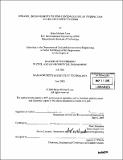Spirasol : improvements to semi-continuous solar disinfection water treatment systems
Author(s)
Loux, Brian Michael, 1981-
DownloadFull printable version (7.184Mb)
Alternative title
Improvements to semi-continuous solar disinfection water treatment systems
Other Contributors
Massachusetts Institute of Technology. Dept. of Civil and Environmental Engineering.
Advisor
Peter Shanahan.
Terms of use
Metadata
Show full item recordAbstract
An experimental study was carried out to determine the feasibility of an original point of use solar water disinfection system created by the author and named "Spirasol." The study primarily focused on the comparison of microbial removal levels in the Spirasol system and the more traditional solar disinfection method called SODIS that uses a Polyethylene Terephthalate (PET) bottle. To address microbial removal capacity, the two systems were assembled and tested in Nairobi, Kenya and later in Cambridge, Massachusetts. The issue of economic feasibility and component availability were also addressed and factored in heavily during the design phase of the project. The results suggest that the Spirasol system is equally as effective as the traditional SODIS system with respect to microbial inactivation. Analysis of the costs required for continuous and semi-continuous solar disinfection system implied that such systems were not a good match for sites of extreme urban poverty such as the Kibera slum in Nairobi, Kenya. However, the overall low cost among semi-continuous point of use treatment systems and the wide availability of the required pieces made them a sustainable technology for other areas in the developing world where available capital is marginally higher.
Description
Thesis (M. Eng.)--Massachusetts Institute of Technology, Dept. of Civil and Environmental Engineering, 2005. Includes bibliographical references (leaves 60-63).
Date issued
2005Department
Massachusetts Institute of Technology. Department of Civil and Environmental EngineeringPublisher
Massachusetts Institute of Technology
Keywords
Civil and Environmental Engineering.